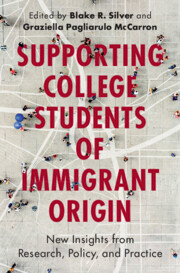Book contents
- Supporting College Students of Immigrant Origin
- Supporting College Students of Immigrant Origin
- Copyright page
- Dedication
- Contents
- Figures
- Tables
- Contributors
- Foreword
- Part I Beginnings
- Part II Experiences
- Part III Institutional Arrangements
- Chapter 12 Student Success Considerations for First-generation, Working-class Latinx College Students
- Chapter 13 Honoring Immigrant College Students’ Funds of Knowledge through Appreciative Advising
- Chapter 14 How Institutional Policies and Practices Impact Black Immigrant College Students’ Experiences
- Chapter 15 Understanding the Personal Support Networks of First-generation College Students from Immigrant Backgrounds
- Chapter 16 Institutional Responsibility for International Student Well-being and Belongingness
- Part IV Looking Forward
- Epilogue
- Index
- References
Chapter 16 - Institutional Responsibility for International Student Well-being and Belongingness
from Part III - Institutional Arrangements
Published online by Cambridge University Press: 16 May 2024
- Supporting College Students of Immigrant Origin
- Supporting College Students of Immigrant Origin
- Copyright page
- Dedication
- Contents
- Figures
- Tables
- Contributors
- Foreword
- Part I Beginnings
- Part II Experiences
- Part III Institutional Arrangements
- Chapter 12 Student Success Considerations for First-generation, Working-class Latinx College Students
- Chapter 13 Honoring Immigrant College Students’ Funds of Knowledge through Appreciative Advising
- Chapter 14 How Institutional Policies and Practices Impact Black Immigrant College Students’ Experiences
- Chapter 15 Understanding the Personal Support Networks of First-generation College Students from Immigrant Backgrounds
- Chapter 16 Institutional Responsibility for International Student Well-being and Belongingness
- Part IV Looking Forward
- Epilogue
- Index
- References
Summary
US universities continue to recruit and engage international students in ways that result in their othering, exclusion, and compromised well-being. As such, scholarship that amplifies the voices of international students attending US colleges is needed. With the increasing attention and push for inclusion and equity work in higher education, it is imperative to account for international students’ experiences within this dialogue and identify policies and practices that will positively contribute to their well-being and success. Using a transnational lens, we interrogate existing systems and offer recommendations to US institutional personnel to better support international student well-being and success. The purpose of this work is twofold: (1) to illuminate how current structures of US higher education systems thwart international students’ well-being and success, and (2) through our analysis of existing literature, to provide recommendations to best support international student well-being and success.
- Type
- Chapter
- Information
- Supporting College Students of Immigrant OriginNew Insights from Research, Policy, and Practice, pp. 332 - 352Publisher: Cambridge University PressPrint publication year: 2024

